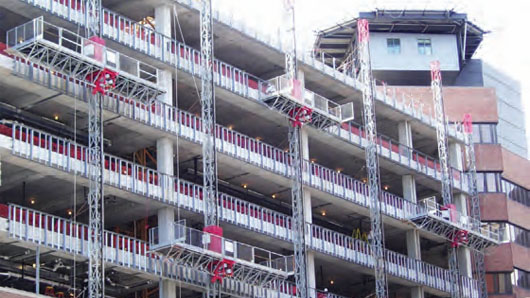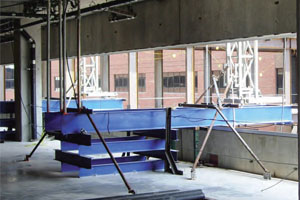July 7, 2009 7:20 AM CDT

When Bob Dylan recorded "Nashville Skyline" in 1969, the result was described as "ground-breaking." As Atlanta-based Mastclimbers LLC continues to explore the true value and flexibility of the product, "ground-breaking" is, again, the phrase that comes to mind.
It was a daunting task indeed: extending the Vanderbilt Hospital at its tightly fit location in downtown Nashville. Bobby Reese, co-founder of Mastclimbers LLC, described the complexity of the task. "The extension to the existing Vanderbilt Hospital is in a tight city center environment. Since the original hospital was built, there have been many building additions and traffic management changes, making it impossible to erect anything from the ground up. We had ambulances racing out of the ground level area and helicopters landing on the helipad on the roof. In between we had to provide façade access for the specialist trades."
The answer? Mount the mast climbers on an arrangement of support beams, keeping everything 75 feet above the busy streets below.
"In addition to the ambulances and helicopter activity (the tower crane had to stop operations when the helicopter was landing/taking off, which was a regular occurrence), there was only room on the job to unload one truck at a time, and concrete drilling was prohibited after 8 a.m.," says Steve Kunz, Mastclimbers' project manager on the job. "But despite all of the obstacles, everyone one delighted with the result."
The challenges were varied, and the most critical part of the process was how to support the mast climber units as well as how to transfer the loads through the structure but not onto it.
"We began by using light, flexible equipment, which put less load on the support structure," says Kevin O'Shea, Mastclimbers director of safety and training, and the International Powered Access Federation's senior instructor in the United States. "We selected the Hek MSM Super and the Safi Jolly Junior, both of which offer fantastic weight to capacity ratios.

"In addition, these units can be built by hand, because the mast sections are light enough to be handled into position," he continues. "They run on electrical power, which was vital because of the problem of noise pollution around the tight city center hospital. After we had designed the support system, which comprised two W14 I-beams positioned on top of a W6 I-beam stack, we worked with our local engineer, Kurt Heinrichs of TEC Services in Lawrenceville, Ga., to verify the integrity of the structure and help design a shoring plan that would effectively negate any load transference onto the floorslab."
Support structures were then set in place, and by careful postioning, the team was able to position the two main W14 beams through a window area opening, minimizing disruption to work on the façade. Finally, the mast was tied at the relevant manufacturer's spacing, between the pre-cast panel openings and down on to the surface of the floor slab.
Finally, delivery of partially assembled mast climbers was scheduled, and they were craned into position.
"When a job like this is first concieved, the strength is in the initial analysis by a trained, competent person," says Kunz. "The worst situation you can have is an untrained sales person making commitments to the customer about performance, productivity and price that are unrealistic. This leads to conflict early in the life of the project, and the mast climber supplier is under operational and financial pressure. This is what leads to a decrease in standards of safety.
"You get one chance to present a credible well-thought-out solution that, as soon as it appears in front of the customer, immediately becomes the blueprint for the success, or failure, of the job," he continues. "It had better be right! Balfour Beatty, the general contractor on the project, needed access to the external façade areas for multi-discipline contractors. The key was to achieve this aim safely, while the hospital continued its day-to-day business undisturbed. We like win-win solutions."
Case Study: Mast Climbers
A new Nashville skyline
By Masonry

Extending the Vanderbilt Hospital at its tightly fit location in downtown Nashville was a daunting task.
When Bob Dylan recorded "Nashville Skyline" in 1969, the result was described as "ground-breaking." As Atlanta-based Mastclimbers LLC continues to explore the true value and flexibility of the product, "ground-breaking" is, again, the phrase that comes to mind.
It was a daunting task indeed: extending the Vanderbilt Hospital at its tightly fit location in downtown Nashville. Bobby Reese, co-founder of Mastclimbers LLC, described the complexity of the task. "The extension to the existing Vanderbilt Hospital is in a tight city center environment. Since the original hospital was built, there have been many building additions and traffic management changes, making it impossible to erect anything from the ground up. We had ambulances racing out of the ground level area and helicopters landing on the helipad on the roof. In between we had to provide façade access for the specialist trades."
The answer? Mount the mast climbers on an arrangement of support beams, keeping everything 75 feet above the busy streets below.
"In addition to the ambulances and helicopter activity (the tower crane had to stop operations when the helicopter was landing/taking off, which was a regular occurrence), there was only room on the job to unload one truck at a time, and concrete drilling was prohibited after 8 a.m.," says Steve Kunz, Mastclimbers' project manager on the job. "But despite all of the obstacles, everyone one delighted with the result."
The challenges were varied, and the most critical part of the process was how to support the mast climber units as well as how to transfer the loads through the structure but not onto it.
"We began by using light, flexible equipment, which put less load on the support structure," says Kevin O'Shea, Mastclimbers director of safety and training, and the International Powered Access Federation's senior instructor in the United States. "We selected the Hek MSM Super and the Safi Jolly Junior, both of which offer fantastic weight to capacity ratios.

Structures were set in place to support the mast climber units.
Support structures were then set in place, and by careful postioning, the team was able to position the two main W14 beams through a window area opening, minimizing disruption to work on the façade. Finally, the mast was tied at the relevant manufacturer's spacing, between the pre-cast panel openings and down on to the surface of the floor slab.
Finally, delivery of partially assembled mast climbers was scheduled, and they were craned into position.
"When a job like this is first concieved, the strength is in the initial analysis by a trained, competent person," says Kunz. "The worst situation you can have is an untrained sales person making commitments to the customer about performance, productivity and price that are unrealistic. This leads to conflict early in the life of the project, and the mast climber supplier is under operational and financial pressure. This is what leads to a decrease in standards of safety.
"You get one chance to present a credible well-thought-out solution that, as soon as it appears in front of the customer, immediately becomes the blueprint for the success, or failure, of the job," he continues. "It had better be right! Balfour Beatty, the general contractor on the project, needed access to the external façade areas for multi-discipline contractors. The key was to achieve this aim safely, while the hospital continued its day-to-day business undisturbed. We like win-win solutions."
About the Author
Masonry, the official publication of the Mason Contractors Association of America, covers every aspect of the mason contractor profession - equipment and techniques, building codes and standards, business planning, promoting your business, legal issues and more. Read or subscribe to Masonry magazine at www.masonrymagazine.com.


















